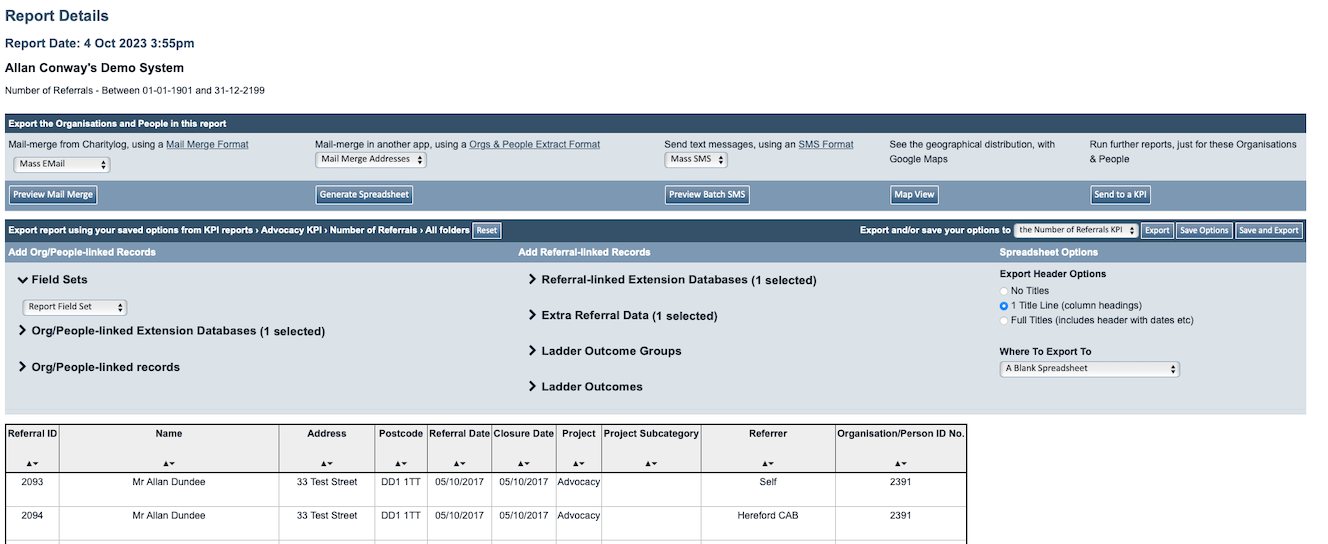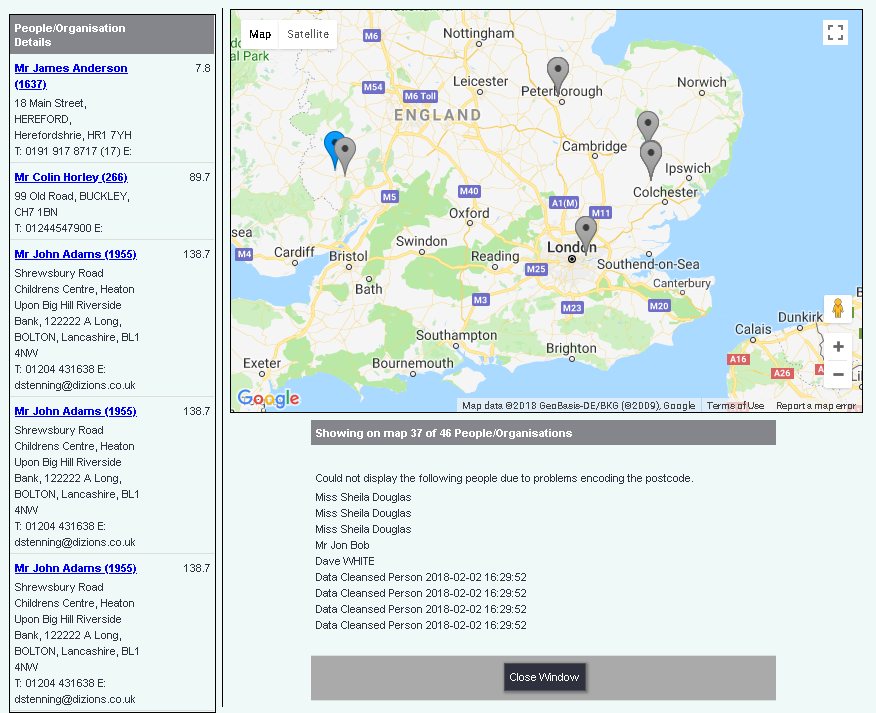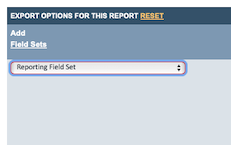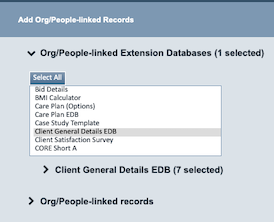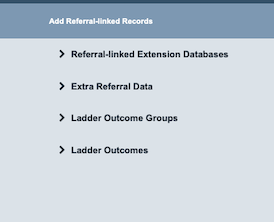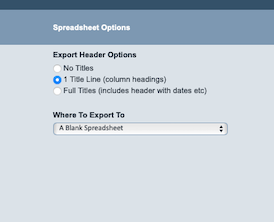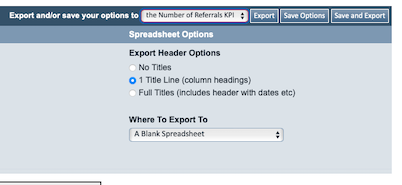Blue Folder Lookup
Contents
- 1 Introduction
- 2 Export Options for the Organisations and People in this Report
- 3 Export Options
- 4 Report Data
- 5 Saving Blue Folder Options
- 6 Limiting Access to Personally Identifiable Information
Introduction
The Blue Folder Lookup page allows you to see the details behind that make up the numbers on a report. For example, if you ask for "number of contacts" using the KPI Report Designer, you will get a total number of contacts; next to the number is a blue folder, which will allow you to see the full details of the contacts counted towards that number. The webinar explains its key functions and additional information is below.
In the blue folder you are able to do the following:
- Mail Merge - This process will allow sending emails, letters from the system to the people/organisations. You can do this via Charitylog using the Preview Mail Merge function or Generate Spreadsheet and export the data into a third party system.
- Map View - Se the location of the people/organisations on a map.
- Extract the data - You are able to extract the data into a spreadsheet for analysis. The extraction can include:
- Additional fields from the person/organisation record.
- Additional information linked to the record, like benefits, disabilities, project record, extension databases (bespoke fields) and more.
- Additional information about the referrals (referral based KPI's), including assessments, extension databases and outcome.
- Use spread sheet templates that can be used for built in analysis for other members of staff.
- Print - Print the summary details that make up the KPI.
The Blue Folder page is split up into three sections:
- Export Options for the Organisations and People in this Report This will export the details based on individuals or organisations to either a mail merge or map. If a person/organisation appears multiple times in the report they will only be exported as one person/organisation.
- Export options for this report - Allows the Report Data to be exported with additional information for analysis.
- The report data - Summary details of the report data.
Export Options for the Organisations and People in this Report
This section will export the details based on individuals or organisations to either a mail merge or map. If a person/organisation appears multiple times in the report they will only be exported as one person/organisation.
Preview Mail Merge
The mail merge option is powered by Mail Merge Formats and will use built-in Letter Templates to generate the mailings. It allows you to:
- Produce a letter - This will allow the printing of multiple letters to the recipients.
- Produce an Email - This will allow the batch of multiple letters to the recipients. It would be recommended to send no more than 300 (use extra criteria on Mail Merge Formats to filter recipients) at a time and to use your own Email Server.
To configure a new Mail Merge Format click on the link 'Mail Merge Format', you will need to re-run the report. If you open up the Mail Merge Format in a new tab you will need to refresh press F5 on the keyboard) the Blue Folder page once its set up.
Select the mail merge format you wish to use and click the 'Confirm Mail Merge' button. Depending on the type of format selected you will then be displayed a summary of the options selected on the mail merge and also a preview of the people selected (and excluded). It is important to remember it is only mailing people already selected by the Blue Folder extract.
Generate Spreadsheet
This function allows you to just extract records and export them into Excel. You can then use a third party product to produce your mailings. You will have to set up an extract which ensures you have selected the correct records and fields. Once you have selected the correct records using a data extract, you can then click on Generate Spreadsheet.
Preview Batch SMS
This allows you to send an SMS to people identified on the blue folder extract. You need to set up a Batch SMS first which can then be applied at the blue folder extract stage. Click on Preview Batch SMS and it will then display a list of selected records before sending the actual SMS.
Map View
The Map View will pin point the location of each person/organisation on the map. On the left hand side you will find a list of people/organisations that appear on the map, and below the mapp you will find details of records that are not on the map as they do not have a correct postal code.
On the map you can click a map pin to view the details of the person/organisation and click again to hide the details. You are able to zoom in if required and a full screen option is available. If you want to take a copy you can either take a screen shot or use a snipping tool.
Click the 'Close Window' button to return to the report data.
Export Options
The export options allow extraction of the data with the ability of adding additional information for analysis in applications like MS Excel. This section is broken down into four columns:
Field Sets
Field Sets specify additional fields from the persons/organisations record. When you select a field set this information will be added to the report data and exported to a spread sheet. click here for a list of available fields.
Add Org/People-linked Records
You are able to include multiple options from the Org/People linked records, use the CTRL on the keyboard to make the selections. The available linked records can be selected:
Extension Database
Extension Databases are groups of bespoke fields that can be added to a records tabs or displayed on the footer of the record. All available Extension Databases will be displayed, this is determined by the type and security of the Extension Database. Once you have selected the relevant extension database, you can then decide which fields will be exported. You can use the CTRL key to select more than one field.
Other org/people-linked records
This section of the list will allow you to attach the following:
- Benefit Details - Details of the benefits recorded via the blue link of a record or on the referral outcomes page. This will include all benefits.
- Benefit Values - Values of the benefits recorded via the blue link of a record or on the referral outcomes page. This will include all benefits.
- Club and Clinic Attendances - Details of Clubs and Clinic attendances for the person/organisation.
- Club and Clinic Memberships - Columns for all Clubs and Clinics with a Y for each Club/Clinic the person/organisation is a member of.
- Consent Options - Details of the Consent Rules recorded on the records.
- Courses and Qualifications - Details of any courses or qualifications (blue links at the base of the record) that are recorded.
- Groups and Skills - Which groups and skill have been added via the bl;ue link on the footer of the record.
- Full Disability Records - Columns for disabilities with a Y for each disability record on the person's/organisation's record.
- In Project Records - Columns for each project with a Y for each project the person/organisation is in or been in.
- NoK and Contacts - Details of the Next of Kins and Contacts recorded using the blue link at the footer of the record.
- Output Areas and Wards - If LSOA Areas and Wards data has been populated and matched with the post code this will be added to the report data.
- Relationships - Attaches the relationship type and the related persons name.
- Relationships (Full details) - Attaches the relationship type and the related persons full details (Name, Contact details and other key fields).
- Carer Relationships - Attaches the carer relationship type and the carers name.
- Carer Relationships (Full details) - Attaches the carers relationship type and the carers full details (Name, Contact details and other key fields).
- Dependant Relationships - Attaches the Cared Fors relationship type and the Cared Fors name (only available on a carer system).
- Dependant Relationships (Full details) - Attaches the Cared Fors relationship type and the Cared Fors full details (Name, Contact details and other key fields) (only available on a carer system).
- Associated People - Attaches the names of associated people to an organisation, this is from the blue link on the footer of an organisation based record type.
- Associated Organisations - Attaches the names of associated organisation to a person, this is from the blue link on the footer of an person based record type.
Multiple selections can be made by holding down the CTRL button on the keyboard. If you select relationships you will be displayed the option to add additional data to those records as well.
Add Referral-linked Records
Assessment Forms (Deprecated Feature)
The answers to each question on the assessment forms selected.
Assessment Scores (Deprecated Feature)
The scores to each question and section on the assessment forms selected.
Extension Databases
Extension Databases are groups of bespoke fields that can be added to a referral. All available Extension Databases will be displayed, this is determined by the type and security of the Extension Database. When you select an Extension database you will then be able to choose which fields you want to add to your extract. This means you can select relevant fields rather than the entire extension database.
Extra Referral Data
Referral link records are only available when reporting on referrals or contacts. Project and person based reports will not show any referral based options. The follow options can be included on the export:
- Extra Referral Data - This will include additional details about the referral.
- Benefit Details - Details of the benefits recorded via the blue link of a record or on the referral outcomes page. This will include only the benefits attached to the referrals linked to the report data.
- Benefit Values - Values of the benefits recorded via the blue link of a record or on the referral outcomes page. This will include only benefit values attached to the referrals linked to the report data.
- Referral Reasons - This will produce a column for each referral reasons and place a Y under the reasons selected on the referral.
- Conflict of Interest - This will include all Conflict of Interests that have been recorded to any referral linked to the report data.
Multiple selections can be made by holding down the CTRL button on the keyboard.
On all of the above it does need consideration to the amount of additional options chosen. If you select too many options this may cause your internet browser to time out or your machine to crash if the spread sheet is too big for the specification of your machine or software.
Spreadsheet Options
Options in this section affect the output of the spread sheet that is exported.
- Export Header Options
- No Titles - just the report and options data, no field titles will be included.
- 1 Title Line (column headings) - The report and options data including field names as headers.
- Full Titles (includes header with dates etc) - Details of the report plus the report and options data including field names as headers.
- Where To Export To
- A blank spreadsheet - the data will appear on a newly created spreadsheet.
- Uploaded Spreadsheet - You will see a list of spreadsheet templates uploaded via System Uploads. The data will be placed on the worksheet specified by the template.
When you have specified your criteria the spreadsheet will be prepared and presented to open or save (depending on your browser).
Report Data
At the bottom of the Blue Folder Lookup page you will see the report data. If you wish to print this click on the 'Print' button.
When you have finished click on the 'Close Report' Button
Saving Blue Folder Options
Once you have established filters on your chosen export, you can instruct the report to remember those options. This means, when you run that particular Blue Folder report in the future, it will extract the same data. Depending on the report which triggered the blue folder, you can then select from relevant options when saving.
Limiting Access to Personally Identifiable Information
You will notice that when you click on a Blue Folder it often reveals personally identifiable information about the people contained in that report. Often, it will display the client's name. You can switch this feature off so that all reports will only display anonymised information. Any subsequent extracts [unless you add a field set] will not include client identifiable information. To switch off identifiable information, head to GDPR Settings, go to Reporting, then choose the No option.

